牛津译林英语9bunit1-reading1教案
- 格式:doc
- 大小:23.00 KB
- 文档页数:2
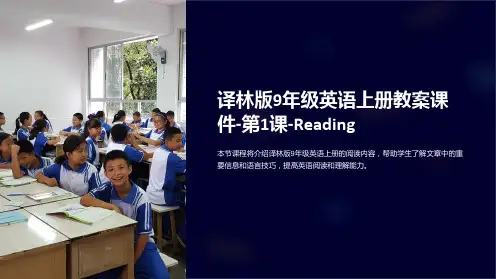
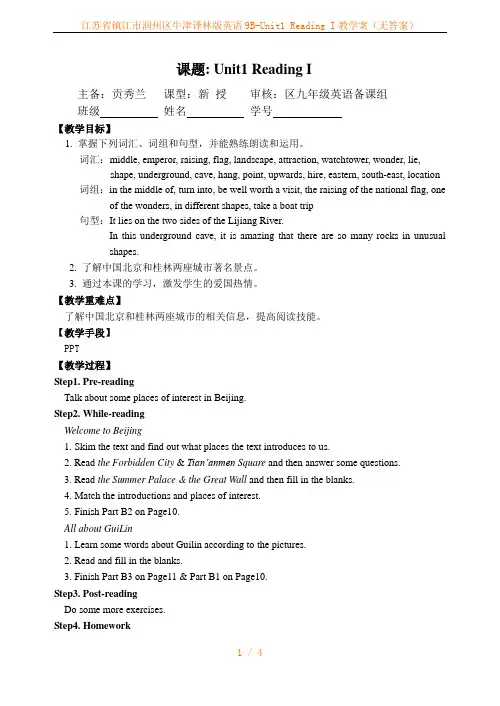
课题: Unit1 Reading I主备:贡秀兰课型:新授审核:区九年级英语备课组班级姓名学号【教学目标】1. 掌握下列词汇、词组和句型,并能熟练朗读和运用。
词汇:middle, emperor, raising, flag, landscape, attraction, watchtower, wonder, lie, shape, underground, cave, hang, point, upwards, hire, eastern, south-east, location 词组:in the middle of, turn into, be well worth a visit, the raising of the national flag, one of the wonders, in different shapes, take a boat trip句型:It lies on the two sides of the Lijiang River.In this underground cave, it is amazing that there are so many rocks in unusualshapes.2. 了解中国北京和桂林两座城市著名景点。
3. 通过本课的学习,激发学生的爱国热情。
【教学重难点】了解中国北京和桂林两座城市的相关信息,提高阅读技能。
【教学手段】PPT【教学过程】Step1. Pre-readingTalk about some places of interest in Beijing.Step2. While-readingWelcome to Beijing1. Skim the text and find out what places the text introduces to us.2. Read the Forbidden City & Tian’anmen Square and then answer some questions.3. Read the Summer Palace & the Great Wall and then fill in the blanks.4. Match the introductions and places of interest.5. Finish Part B2 on Page10.All about GuiLin1. Learn some words about Guilin according to the pictures.2. Read and fill in the blanks.3. Finish Part B3 on Page11 & Part B1 on Page10.Step3. Post-readingDo some more exercises.Step4. HomeworkFinish off the exercises.【课堂巩固】词汇运用。
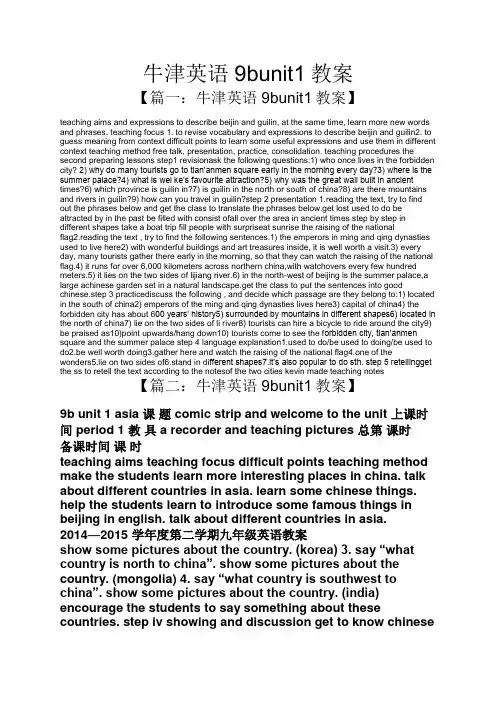
牛津英语9bunit1教案【篇一:牛津英语9bunit1教案】teaching aims and expressions to describe beijin and guilin, at the same time, learn more new words and phrases. teaching focus 1. to revise vocabulary and expressions to describe beijin and guilin2. to guess meaning from context difficult points to learn some useful expressions and use them in different context teaching method free talk, presentation, practice, consolidation. teaching procedures the second preparing lessons step1 revisionask the following questions:1) who once lives in the forbidden city? 2) why do many tourists go to tian’anmen square early in the morning every day?3) where is the summer palace?4) what is wei ke’s favourite attraction?5) why was the great wall built in ancient times?6) which province is guilin in?7) is guilin in the north or south of china?8) are there mountains and rivers in guilin?9) how can you travel in guilin?step 2 presentation 1.reading the text, try to find out the phrases below and get the class to translate the phrases below.get lost used to do be attracted by in the past be filled with consist ofall over the area in ancient times step by step in different shapes take a boat trip fill people with surpriseat sunrise the raising of the nationalflag2.reading the text , try to find the following sentences.1) the emperors in ming and qing dynasties used to live here2) with wonderful buildings and art treasures inside, it is well worth a visit.3) every day, many tourists gather there early in the morning, so that they can watch the raising of the national flag.4) it runs for over 6,000 kilometers across northern china,with watchovers every few hundred meters.5) it lies on the two sides of lijiang river.6) in the north-west of beijing is the summer palace,a large achinese garden set in a natural landscape.get the class to put the sentences into good chinese.step 3 practicediscuss the following , and decide which passage are they belong to:1) located in the south of china2) emperors of the ming and qing dynasties lives here3) capital of china4) the forbidden city has about 600 years’ history5) surrounded by mountains in different shapes6) located in the north of china7) lie on the two sides of li river8) tourists can hire a bicycle to ride around the city9) be praised as10)point upwards/hang down10) tourists come to see the f orbidden city, tian’anmen square and the summer palace step 4 language ed to do/be used to doing/be used to do2.be well worth doing3.gather here and watch the raising of the national flag4.one of thewonders5.lie on two sides of6.stand in di fferent shapes7.it’s also popular to do sth. step 5 retellingget the ss to retell the text according to the notesof the two cities kevin made teaching notes【篇二:牛津英语9bunit1教案】9b unit 1 asia 课题 comic strip and welcome to the unit 上课时间 period 1 教具 a recorder and teaching pictures 总第课时备课时间课时teaching aims teaching focus difficult points teaching method make the students learn more interesting places in china. talk about different countries in asia. learn some chinese things. help the students learn to introduce some famous things in beijing in english. talk about different countries in asia. 2014—2015 学年度第二学期九年级英语教案show some pictures about the country. (korea) 3. say “what country is north to china”. show some pictures about the country. (mongolia) 4. say “what country is southwest to china”. show some pictures about the country. (india) encourage the students to say something about these countries. step iv showing and discussion get to know chinesethings. 1. show the pictures about chinese things such as: dragon dance, chinese opera, chopsticks, chinese knot, chinese paper cut and chinese kung fu. 2. encourage the students to talk about the pictures. 3. encourage the studentsto say more about chinese things. 4. get the students to talk about some famous chinese things. step v practice finish the exercises in part a. talk about the places of interest in china. step viconsolidation write a short passage to describe one of the famous places in china and choose a piece of writing to read in class. step5:homeworkteaching notes -2-2014—2015 学年度第二学期九年级英语教案9b unit1 asia课题备课时间课时 teaching aims teaching focus difficultpoints teaching methodreading 1 上课时间 period 2 教具总第课时a recorder1. to guess general meanings from keywords and context2. to skim text for overall meanings and scan for details help the ss to learn to introduce the places of interest in beijing and guilin talk about the places of interest in beijing and guilin task-based approach teaching procedures the second preparing lessonsstep 1free talk 1. show a map of china, ask: where would you like to go? 2. have a brief introduction of beijing. 3. show some pictures about places of interest in beijing and ask: why do so many people dream of being to beijing? step 2presentation 1. ask students to use different words to describe beijing. 2.teach some new words 3. get students to go through the text and answer some questions 1) who once lived in the forbidden city? 2) why do many tourists go to tian?anmen square early in the morning every day? 3) where is the summer palace? 4)what is wei ke?s favorite attraction? 5) why was the great wall built in ancient times? 6) is guilin in the north or south of china?7) are there mountains and rivers in guilin? 8) how can you travel in guilin? step 3further reading match the places the palace museum next to the palace museum tian?anmen square in the middle of beijing the summer palace in the north of beijing the great wall in the north-west of beijing [来源:立网] -3-2014—2015 学年度第二学期九年级英语教案read it again and do some true or false questions 1)beijing is in southern china. 2)tian?anmen square is close to the forbidden city. 3)the great wall is built around the forbidden city. 4) the reed flute cave is in eastern guilin 5) you can find man-made lakes inside the reed flute cave. 6) we can take a boat trip along li river read the two parts carefully to get some details. 1) match the name with the correct information. 2) ask some questions and get the students to answer. 3) fill in blanks according to the passage. step 4 consolidation do some exercises on the exercise book. 2. post-teaching demands(要求): 1)group one asks questions about beijing and group two answers them. 2)group two asks questions about guilin and group one answers them. . rules: 1) time :only one minute. 2) ask and answer as quickly as possible . 3)one question, one point; one answer, one point. 4) the more, the better. step5 homework 1.think over how to introduce a city 2.have a try introduce our hometown to allteaching notes -4-2014—2015 学年度第二学期九年级英语教案9b unit 1 asia 课题 reading 2 上课时间 period3 教具 a recorder and teaching pictures 总第课时备课时间课时teaching aims teaching focus difficult points teaching method to revise vocabulary and expressions to describe beijin and guilin, at the same time, learn more new words and phrases. 1. to revise vocabulary and expressions to describe beijin and guilin 2. to guess meaning from context to learn some useful expressions and use them in different context free talk, presentation, practice, consolidation. teaching procedures the second preparing lessonsstep1 revision ask the following questions: 1) who once lives in the forbidden city? 2) why do many tourists go totian?anmen square early in the morning every day? 3) where is the summer palace? 4) what is wei ke?s favourite attraction? 5) why was the great wall built in ancient times? 6) which province is guilin in? 7) is guilin in the north or south of china?8) are there mountains and rivers in guilin? 9) how can you travel in guilin? step 2 presentation 1.reading the text, try tofind out the phrases below and get the class to translate the phrases below. get lost used to do be attracted by in the past be filled with consist of all over the area in ancient times step by step in different shapes take a boat trip fill people with surprise at sunrise the raising of the national flag 2.reading the text , try to find the following sentences. 1) the emperors in ming and qing dynasties used to live here 2) with wonderful buildings and art treasures inside, it is well worth a visit. 3) every day, many tourists gather there early in the morning, so that they can watch the raising of the national flag. -5-【篇三:牛津英语9bunit1教案】9b unit1 life on marsagainst(反方): i don’t believe so because….5.fill in the chart.life on earth todaylife on mars in 2100课堂达标检测词组翻译:1.难以想象2.到2100年3.目前4.变得越来越拥挤,污染5.以光速的一半6. 对早期的定居者来说是一个问题7.八分之三的 8.使许多人感觉不舒服9.漂浮在太空 10.在许多方面学习感悟:课题9b unit1 reading ii学习目标知识目标学习关于性格特征的形容词,巩固本课所学的相关表达法,并能灵活运用。
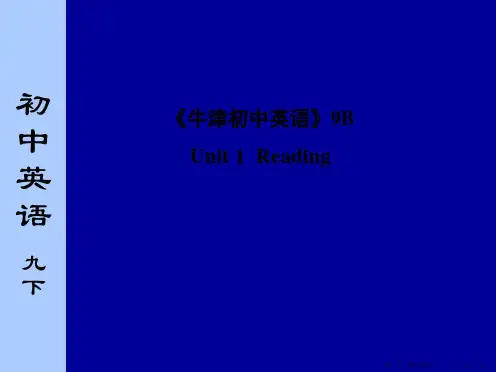
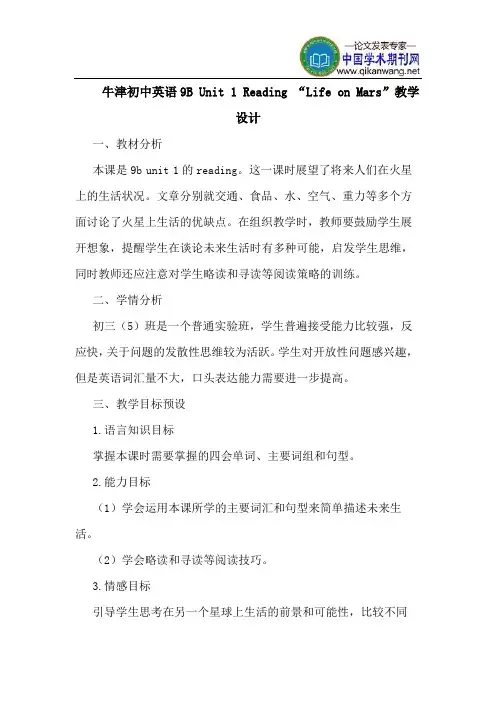
牛津初中英语9B Unit 1 Reading “Life on Mars”教学设计一、教材分析本课是9b unit 1的reading。
这一课时展望了将来人们在火星上的生活状况。
文章分别就交通、食品、水、空气、重力等多个方面讨论了火星上生活的优缺点。
在组织教学时,教师要鼓励学生展开想象,提醒学生在谈论未来生活时有多种可能,启发学生思维,同时教师还应注意对学生略读和寻读等阅读策略的训练。
二、学情分析初三(5)班是一个普通实验班,学生普遍接受能力比较强,反应快,关于问题的发散性思维较为活跃。
学生对开放性问题感兴趣,但是英语词汇量不大,口头表达能力需要进一步提高。
三、教学目标预设1.语言知识目标掌握本课时需要掌握的四会单词、主要词组和句型。
2.能力目标(1)学会运用本课所学的主要词汇和句型来简单描述未来生活。
(2)学会略读和寻读等阅读技巧。
3.情感目标引导学生思考在另一个星球上生活的前景和可能性,比较不同环境的优点和缺点,激发学生探索未知世界的热情。
四、教材重点、难点五、教学重难点1.重点(1)学习和运用四会单词、词组,通过阅读课文内容获取信息。
(2)在阅读中不断操练略读和寻读等阅读技巧。
2.难点在理解文章大意的基础上,通过组织教学活动,促进学生思维发展,激发探索未知世界的热情。
五、教学策略教学思路:1.lead-in(通过视频导出生词并使学生对火星的基本情况有所了解。
)2.first reading (通过skimming的阅读技巧,回答一个基本问题,了解文章大意。
)3.seconding reading(通过scanning的阅读技巧,先找出各小节的关键词。
然后通过回答问题、改错、填空等活动将文章分块阅读,获取细节信息。
)4. third reading (通读全文,概括火星生活的优缺点。
)5.reading for development(通过学生间的采访活动输出阅读获取信息;通过观看人类探索火星取得的成就视频,引发学生思考,升华情感。
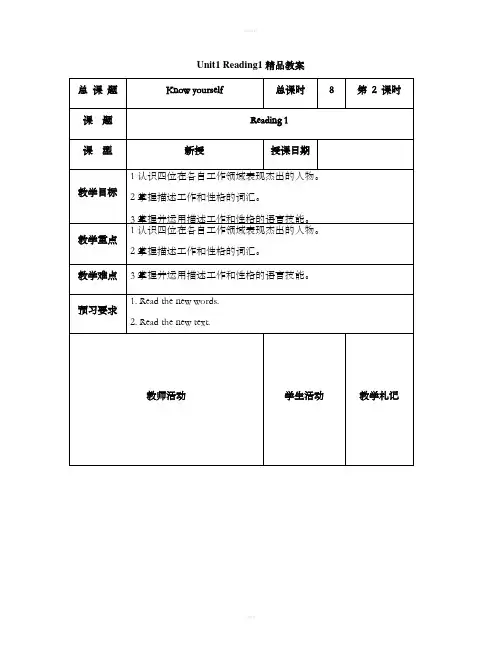

9B Unit 1 Asia9B Unit1 Asia9B Unit 1 Asia9Bunit1 Asia9BUnit 1 Asia9B Unit4 Asia9BUnit 1Asia课题Revision 总第课时备课时间上课时间课时Period 8 教具 A recorderTeaching aims To review key grammar and vocabulary itemsTo give students the chance to practise the grammar and vocabulary itemsTo allow students to check their progress and ask any questions they may still haveTeachingfocusTo review key grammar and vocabulary itemsDifficultpointsTo check their progress and tr y to ask questions they may have TeachingmethodT ask-based approach,Scene pedagogy and Teaching with humorTeaching procedures The second preparinglessonsStep 1 Warming-upTian’anmen Square go ontravel around Chinastart from herethe Palace Museumdragon danceChinese kung fuwonderful places to goa kind of traditional Chinese art a long way to gogo on travel around China start from here the Palace Museum dragon dance Chinese kung fu wonderful places to goa kind of traditional Chinese artStep2Language points1. The Great Wall is amazing, isn’t it?.They are students, aren’t they?He's to go home via Hongkong, isn't?Let's meet at the airport, shall we ?Have a little more wine, will you ?2The emperors of the Ming and Qing dynasties used to live here. (line10)used to do sth. : did something repeatedly in the past 过去常常(现在不了)eg. His careless driving led to the traffic accident.be/get used to doing sth. : 习惯做某事e.g. I am used to getting up early.be used to do. : 被用来做某事e.g. Brooms are used to sweep the floor.be(well)worth sth 非常值得…raise vt.举起,提起(某物)rise vi.(某物)上升,升起some…others…一些,一些;有的…有的…be praised as Art Palace of Nature。
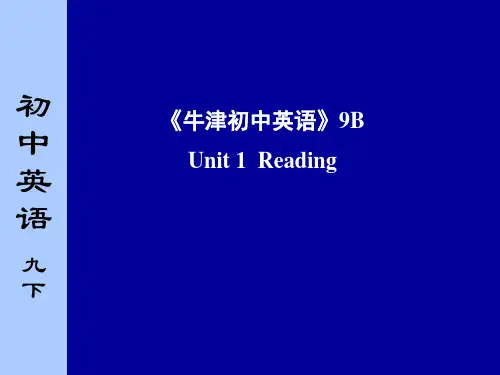

9B Unit 1Asia课题Comic strip and Welcome to the unit 总第课时备课时间上课时间课时Period 1 教具 A recorder and teaching picturesTeaching aims Make the students learn more interesting places in China. Talk about different countries in Asia.Learn some Chinese things.TeachingfocusHelp the students learn to introduce some famous things in Beijing in English. DifficultpointsTalk about different countries in Asia.TeachingmethodFree talk, Presentation, Practice, Consolidation.Teaching proceduresThe secondpreparing lessonsStep1 Lead-inTalking about the places of interest in Beijing.1. Show some pictures to the students. Get them to guess what it is.2. Encourage the students to describe them.Step II Listen and readTell the students that Eddie and Hobo are visiting the Great Wall.a.Get the students to listen to the tape and find out what happened. 1)What happened to Hobo’s feet?2)What was he doing then?3)What did Hobo advise Eddie to do?4)What was Eddie’s decision?. Get the students to read and practice the dialogue and then act the dialogue out.Step III PresentationGet to know the countries in Asia.1. Say “what country is east to China”.Show some pictures about the country. (Japan)2. Say “what country is northeast to China”.Ask:How does Mille learn about the world?why?How does Simon learn about the wwrld? Why?Work in pairs to practice the dialogue.Sample conversation :S1:How do you learn about the world?Show some pictures about the country. (Korea)3. Say “what country is north to China”.Show some pictures about the country. (Mongolia)4. Say “what country is southwest to China”.Show some pictures about the country. (India) Encourage the students to say something about these countries. Step IVShowing and discussionGet to know Chinese things.1. Show the pictures about Chinese things such as: dragon dance, Chinese opera, chopsticks,Chinese knot,Chinese paper cut and Chinese kung fu.2. Encourage the students to talk about the pictures.3. Encourage the students to say more about Chinese things.4. Get the students to talk about some famous Chinese things.Step V PracticeFinish the exercises in Part A.Talk about the places of interest in China.Step VIConsolidationWrite a short passage to describe one of the famous places in China and choose a piece of writing to read in class.Step5:HomeworkTeachingnotes9BUnit1Asia Teaching aims 1. To guess general meanings from keywords and context 2. To skim text for overall meanings and scan for detailsTeachingfocusHelp the Ss to learn to introduce the places of interest in Beijing and Guilin DifficultpointsTalk about the places of interest in Beijing and GuilinTeachingmethodTask-based approachTeaching procedures The second课 题 Reading 1 总第 课时 备课时间 上课时间课 时 Period 2 教 具 A recorderpreparing lessons Step 1Free Talk1. Show a map of China, ask: Where would you like to go?2. Have a brief introduction of Beijing.3. Show some pictures about places of interest in Beijing and ask: Why do so manypeople dream of being to Beijing?Step 2Presentation1. Ask students to use different words to describe Beijing.2. Teach some new words3. Get students to go through the text and answer some questions1) Who once lived in the Forbidden City?2) Why do many tourists go to Tian’anmen Square early in the morning every day?3) Where is the SummerPalace?4) What is Wei Ke’s favorite attraction?5) Why was the Great Wall built in ancient times?6) Is Guilin in the north or south of China?7) Are there mountains and rivers in Guilin?8) How can you travel in Guilin?Step 3Further readingMatch the placesthe PalaceMuseum next to the PalaceMuseum Tian’anmen Square in the middle of Beijingthe SummerPalace in the north of Beijingthe Great Wall in the north-west of Beijing Read it again and do some true or false questions1)Beijing is in southern China.2)Tian’anmen Square is close to the Forbidden City.3)The Great Wall is built around theForbidden City.4) The ReedFluteCave is in eastern Guilin5) You can find man-made lakes insidethe ReedFluteCave.6) We can take a boat trip along Li RiverRead the two parts carefully to get some details.1) Match the name with the correct information.2) Ask some questions and get the students to answer.3) Fill in blanks according to the passage.Step 4 ConsolidationDo some exercises on the exercise book.2. Post-teachingDemands(要求):1)Group one asks questions about Beijing and group two answers them.2)Group two asks questions about Guilin and group one answers them. . Rules:1) Time :only one minute.2) Ask and answer as quickly as possible .3)one question, one point; one answer, one point.4) The more, the better.Step5 Homework1.Think overhow to introduce a city2.Have a tryintroduce our hometown to allTeachingnotes9B Unit 1Asia课题Reading 2 总第课时备课时间上课时间课时Period3 教具 A recorder and teaching picturesTeaching aims To revise vocabulary and expressions to describe Beijin and Guilin, at the same time, learn more new words and phrases.Teaching focus 1. To revise vocabulary and expressions to describe Beijin and Guilin2. To guess meaning from contextDifficultpointsTo learn some useful expressions and use them in different contextTeachingmethodFree talk, Presentation, Practice, Consolidation.Teaching proceduresThe secondpreparing lessonsStep1 RevisionAsk the following questions:1) Who once lives in the Forbidden City?2) Why do many tourists go to Tian’anmen Square early in the morning every day?3) Where is the SummerPalace?4) What is Wei Ke’s favourite attraction?5) Why was the Great Wall built in ancient times?6) Which province is Guilin in?7) Is Guilin in the north or south of China?8) Are there mountains and rivers in Guilin?9) How can you travel in Guilin?Step 2 Presentation1.Reading the Text, try to find out the phrases below and get the class to translate the phrases below.get lostused to dobe attracted by in the pastbe filled with consist ofall over the area in ancient timesstep by step in different shapestake a boat trip fill people with surpriseat sunrise the raising of the national flag2.Reading the text , try to find the following sentences.1) The emperors in Ming and Qing Dynasties used to live here2) With wonderful buildings and art treasures inside, it is well worth a visit.3) Every day, many tourists gather there early in the morning, so that they can watch the raising of the national flag.4) It runs for over 6,000 kilometers across northern China,with watchovers every few hundred meters.5) It lies on the two sides of LiJiangRiver.6) In the north-west of beijing is The Summer Palace,a large achinese garden set in a natural landscape.Get the class to put the sentences into good Chinese.Step 3 PracticeDiscuss the following , and decide which passage are they belong to:1) located in the south of China2) emperors of the Ming and Qing dynasties lives here3) capital of China4) the Forbidden City has about 600 years’ history5) surrounded by mountains in different shapes6) located in the north of China7) lie on the two sides of Li River8) tourists can hire a bicycle to ride around the city9) be praised as10)point upwards/hang down10) tourists come to see the Forbidden City, Tian’anmen Square and the SummerPalaceStep 4 language explanationed to do/be used to doing/be used to do2.be well worth doing3.gather here and watch the raising of the national flag4.one of the wonders5.lie on two sides of6.stand in different shapes7.It’s also popular to do sth.Step 5RetellingGet the Ss to retell the text according to the notesof the two cities Kevin madeTeachingnotes9Bunit1 Asia课题Grammar 总第课时备课时间上课时间课时Period 4 教具Pictures tape Teaching Get the Ss to know the use of “it”aimsTeaching focus Use it as a pronounUse it as an impersonal pronounUse it to replace the real subject or objectDifficultpointsLearn to use it correctlyTeachingmethodTask-based approach,Scene pedagogy and Teaching with humorTeaching proceduresThe second preparinglessonsStep 1 RevisionReview the following sentences with “ it”Look at the panda,it is so small.Another famous attraction is the Grate Wall,it runs…Look at the cute baby, it is a boy ,isn’t it?The little baby is drinking milk.It weighs only 3 kilos.--Who was calling you just now?--It was my cousin.Tourists like to take a boat trip along the LijiangRiver.It is a great fun.Step 2 Working out the rulesWe use it for animals and lifeless thingsWe use it for a young child when we don’t know whether it is a boy or a girlWe use it for an attractionWe use it for an unknown personStep 3 PracticeDo the exercise in Part AStep 4Learn the use of it as an impersonal pronounIt’s 6:30p.m. It is raining heavily.In Beijing, it is cold.It is 2 kilometers from here to your school.It is 6:30 p.m. It is raining heavily outside.It is 1 January today. It is New Year’s Day.In Beijing, it is cold and windy in winter.It is two kilometres from my school to my____ was a sunny day. Peter decided to go for a walk to the park, though _____ was two miles away. ___ was so comfortable to walk on the street.Step 5 Do the exercise in partBStep 6 Learn the use of it ---to replace the real subject or objectIt is very tiring ti climb the steps.It is +adj.+(of/for…)+to do sthIt takes …some time to do sth.It issaid/reported… that……thinks/finds it easy /difficult to do sth…It is amazing that there are so many rocks in unusual shapes in the cave.It is important that we should learn English well.It is very tiring to climb the steps.It is popular to hire a bicycle and ride around the countrysideMany people find it pleasant to travel around.We think it important to learn a foreign language.该句型中的it 作形式宾语,为了记忆方便我们可称该句型为"6123结构"。

初三年级9B教案总课题9B Unit 1 Life on Mars总课时10第1课时课题Welcome to this unit课型New教学目标知识目标To learn some new words and expression_rs能力目标To think about life in the future.To discuss the advantages of a given situation 情感目标To love the nature and treasure our globe教学重点To learn some new words and expression_rs教学难点To discuss the advantages of a given situation 教学准备 A computer, notebooks and work sheets.课前预习Try reading the parts and search for some information about Mars online if possible.学情分析The students are sure to be interested in studying something about other planets, however, they may feel it difficult to learn some expression_rs in English.教学过程教学环节教师活动学生活动设计意图Step 1 Lead-inStep 2 PresentationStep 3 Presentation Say: What are life like now?What life will be like on theearth in the future ? What willpeople do in the future?Show some pictures :Review“robot ”, “helmets”,“pills” and complain MarsExplain the context of PartA .Daniel is thinking about whatit might be like to live on Mars.He is comparing life on earth towhat life might be like on Marsand whether Mars would be abetter or worse place to live.Check the students’ answers.Ask students to work in pairs tocomplete Part B .Ask one studentto read out the name of eachobject in turn. Then askListen to theteacher and tryto catch themain points.Learn some newwords.Listen andcatch the mainpoints.营造氛围,激发兴趣。
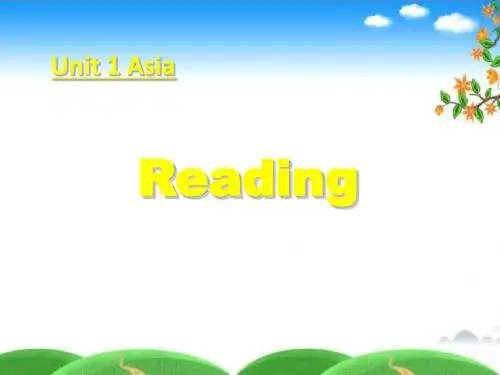
第二学期九年级英语教学设计9B Unit 1 Asia 课题Comic strip and Welcome to the unit总第课时备课时间上课时间课时Period 1教具 A recorder and teaching picturesMake the students learn more interesting places in China.TeachingTalk about different countries in Asia.aimsLearn some Chinese things.TeachingHelp the students learn to introduce some famous things in Beijing in English. focusDifficultTalk about different countries in Asia.pointsTeachingFree talk, Presentation, Practice, Consolidation.methodThe secondTeaching procedurespreparing lessonsStep1 Lead-inTalking about the places of interest in Beijing.1.Show some pictures to the students. Get them to guess what it is.2.Encourage the students to describe them.Step II Listen and readTell the students that Eddie and Hobo are visiting the Great Wall. a. Get the students to listen to the tape and find out what happened.1) What happened to Hobo?s feet?2) What was he doing then?3) What did Hobo advise Eddie to do?4) What was Eddie?s decision?. Get the students to read and practice the dialogue and then act the dialogue out.Step III PresentationGet to know the countries in Asia.1. Say“ what country is east to China.”Show some pictures about the country. (Japan)2. Say “ what country is northeast to China.”Ask:How does Mille learn about the world?why?How does Simon learn about the wwrld? Why?Work in pairs to practice the dialogue.Sample conversation :S1:How do you learn about the world?Show some pictures about the country. (Korea)3. Say “ what country is north to China. ”Show some pictures about the country. (Mongolia)4. Say “ what country is southwest to China. ”Show some pictures about the country. (India)Encourage the students to say something about these countries. Step IV Showing and discussionGet to know Chinese things.1.Show the pictures about Chinese things such as: dragon dance,Chinese opera, chopsticks, Chinese knot, Chinese paper cut and Chinese kung fu.2.Encourage the students to talk about the pictures.3.Encourage the students to say more about Chinese things.4.Get the students to talk about some famous Chinese things.Step V PracticeFinish the exercises in Part A.Talk about the places of interest in China.Step VIConsolidationWrite a short passage to describe one of the famous places in China and choose a piece of writing to read in class.Step5:HomeworkTeachingnotes9B Unit1 Asia课题Reading 1总第课时备课时间上课时间课时Period 2教具 A recorderTeaching 1. To guess general meanings from keywords and contextaims 2. To skim text for overall meanings and scan for detailsTeachingHelp the Ss to learn to introduce the places of interest in Beijing and GuilinfocusDifficultTalk about the places of interest in Beijing and GuilinpointsTeachingTask-based approachmethodTeaching procedures The secondpreparing lessons Step 1Free Talk1.Show a map of China, ask: Where would you like to go?2.Have a brief introduction of Beijing.3.Show some pictures about places of interest in Beijing and ask: Why do so manypeople dream of being to Beijing?Step 2Presentation1.Ask students to use different words to describe Beijing. [根源立网]2.Teach some new words3.Get students to go through the text and answer some questions1) Who once lived in the Forbidden City?2) Why do many tourists go to Tian ?anmen Square early in the morning every day?3) Where is the Summer Palace?4) What is Wei Ke ?s favorite attraction?5) Why was the Great Wall built in ancient times?6)Is Guilin in the north or south of China?7)Are there mountains and rivers in Guilin?8)How can you travel in Guilin?Step 3Further readingMatch the placesthe Palace Museum next to the Palace Museum Tian?anmen Square in the middle of Beijingthe Summer Palace in the north of Beijingthe Great Wall in the north-west of Beijing Read it again and do some true or false questions1) Beijing is in southern China.2) Tian?anmen Square is close to the Forbidden City.3) The Great Wall is built around theForbidden City.4) The Reed Flute Cave is in eastern Guilin5)You can find man-made lakes inside the Reed Flute Cave.6)We can take a boat trip along Li RiverRead the two parts carefully to get some details.1)Match the name with the correct information.2)Ask some questions and get the students to answer.3)Fill in blanks according to the passage.Step 4 ConsolidationDo some exercises on the exercise book.2. Post-teachingDemands(要求 ):1)Group one asks questions about Beijing and group two answers them.2)Group two asks questions about Guilin and group one answers them. . Rules:1)Time : only one minute.2)Ask and answer as quickly as possible .3)one question, one point; one answer, one point.4)The more, the better.Step5 Homework 1.Thinkoverhow to introduce acity 2.Have a tryintroduce our hometown to allTeachingnotes9B Unit 1 Asia课题Reading 2总第课时备课时间上课时间课时Period3教具 A recorder and teaching picturesTeaching aims Teaching To revise vocabulary and expressions to describe Beijin and Guilin, at the same time, learn more new words and phrases.1. To revise vocabulary and expressions to describe Beijin and Guilinfocus 2. To guess meaning from contextDifficultTo learn some useful expressions and use them in different contextpointsTeachingFree talk, Presentation, Practice, Consolidation.methodThe secondTeaching procedurespreparing lessonsStep1 RevisionAsk the following questions:1)Who once lives in the Forbidden City?2)Why do many tourists go to Tian?anmen Square early in the morning every day?3)Where is the Summer Palace?4)What is Wei Ke?s favouri te attraction?5)Why was the Great Wall built in ancient times?6)Which province is Guilin in?7)Is Guilin in the north or south of China?8)Are there mountains and rivers in Guilin?9)How can you travel in Guilin?Step 2 Presentation1.Reading the Text, try to find out the phrases below and get the class to translate the phrases below.get lost used to dobe attracted by in the pastbe filled with consist ofall over the area in ancient timesstep by step in different shapestake a boat trip fill people with surpriseat sunrise the raising of the national flag2.Reading the text , try to find the following sentences.1)The emperors in Ming and Qing Dynasties used to live here2)With wonderful buildings and art treasures inside, it is well worth a visit.3)Every day, many tourists gather there early in the morning, so that they can watch the raising of the national flag.4) It runs for over 6,000 kilometers across northern China,with watchovers every few hundred meters.5) It lies on the two sides of LiJiang River.6)In the north-west of beijing is The Summer Palace,a large achinese garden set in a natural landscape.Get the class to put the sentences into good Chinese.Step 3 PracticeDiscuss the following , and decide which passage are they belong to:1)located in the south of China2)emperors of the Ming and Qing dynasties lives here3)capital of China4)the Forbidden City has about 600 years? history5)surrounded by mountains in different shapes6)located in the north of China7)lie on the two sides of Li River8)tourists can hire a bicycle to ride around the city9)be praised as10)point upwards/hang down10) tourists come to see the Forbidden City, Tian?anmen Squ are and the Summer PalaceStep 4language explanationed to do/be used to doing/be used to do2.be well worth doing3.gather here and watch the raising of the national flag4.one of the wonders5.lie on two sides of6.stand in different shapes7.It ?s also popular to do sth.Step 5 RetellingGet the Ss to retell the text according to the notesof the two cities Kevin madeTeachingnotes9Bunit1 Asia课题Grammar总第课时备课时间上课时间课时Period 4教具Pictures tape Teaching Get the Ss to know the use of “it ”aimsUse it as a pronounTeachingUse it as an impersonal pronounfocusUse it to replace the real subject or objectDifficultLearn to use it correctlypointsTeachingTask-based approach Scene pedagogy and Teaching with humor methodThe second preparing Teaching procedureslessonsStep 1 RevisionReview the following sentences with“it”Look at the panda,it is so small.Another famous attraction is the Grate Wall,it runsLook at the cute baby, it is a boy ,isn ?t it?The little baby is drinking milk.It weighs only 3 kilos.--Who was calling you just now?--It was my cousin.Tourists like to take a boat trip along the Lijiang River.It is a great fun.Step 2 Working out the rulesWe use it for animals and lifeless thingsWe use it for a young child when we don ?t know whether it is a boy or a girlWe use it for an attractionWe use it for an unknown personStep 3 PracticeDo the exercise in Part AStep 4Learn the use of it as an impersonal pronounIt ?s 6:30p.m. It is raining heavily.In Beijing, it is cold.It is 2 kilometers from here to your school.It is 6:30 p.m. It is raining heavily outside.It is 1 January today. It is New Year’s Day.In Beijing, it is cold and windy in winter.It is two kilometres from my school to my____ was a sunny day. Peter decided to go for a walk to the park, though _____ was two miles away. ___ was so comfortable to walk on the street.Step 5 Do the exercise in partBStep 6 Learn the use of it ---to replace the real subject or objectIt is very tiring ti climb the steps.It is +adj.+(of/for)+to do sthIt takes some time to do sth.It is said/reported thatthinks/finds it easy /difficult to do sthIt is amazing that there are so many rocks in unusual shapes in the cave.It is important that we should learn English well.It is very tiring to climb the steps.It is popular to hire a bicycle and ride around the countrysideMany people find it pleasant to travel around.We think it important to learn a foreign language.该句型中的it 作形式宾语,为了记忆方便我们可称该句型为 "6123 构造 " 。
Unit 1 Know yourselfReading设计说明教学反思首先通过图片呈现生词,导入新课,然后根据不同的任务引导学生逐步理解课文,逐步通晓阅读的技巧,最后解决课文中的重要知识点,为更好地掌握课文扫清障碍。
教学目标通过本课时的教学,让学生达成以下目标:1.知识目标掌握单词和短语:born, impress, sculpture, praise, general, race, lead, challenge, chief, high-speed, connect, miss, attention, standard, pioneer,surgeon, carelessness, extra, devote, respect, suitable, partner, either…or…,take the lead, fall behind, connect to/with, as good as, pay attention to。
2.能力目标通过阅读,提高学生阅读的能力,逐步掌握略读的阅读技巧。
3.情感目标培养学生良好的个人品质,学会热爱本职工作,为将来工作做好准备。
重点难点重点:学习并掌握本课时的单词和短语,理解文章大意,掌握重要句型。
难点:掌握略读的阅读技巧。
教学准备PPT 课件;相关图片。
授课时数2课时教学过程Step 1 Lead-inAsk and answer questions very quickly.·What does your father do?·Where does he work?·Does he love his work?·What is his personality?·Is he suitable for his job?…Step 2 Presentation1. Show some new words by showing them some pictures. The teacher uses a whole passage to join the words together.the high-speed highway; praise; sculpture; impress; pioneer; take the lead; work to high standards; general manager2. Read the new words.3. Do B1. Match the words with their meanings.Answers: 1. c 2. e 3. a 4. b 5. d 6. fStep 3 ReadingTask 1 First reading—Skimming1. Show the four people. Read the passage very quickly and find out the answers: Who are they? What do they do?2. Ask the students how they can get the answers so quickly. Tell them the reading skills: Get the information from the pictures.Task 2 Second reading—ScanningB2 Read the passage and judge the sentences:Answers: 1. F 2. T 3. F 4. T 5. F 6. F 7. T 8. TTask 3 Third reading—Read the passage in detail.1. Read Para.1 and answer the questions.(1)What does his best friend think of him?(2)What has won high praise from the art community?(3)What does he want to share with people?(4)What is he always searching for?Answers:(1)He is quiet and doesn’t like to talk much,but his work shouts.(2)His sculptures for Sunshine Town Square.(3) He wants to share the best art with people.(4)He is always searching for something better or different.2. Read Para. 2 and fill in the form.Liu Hao is the chief engineer of __________ connecting Sunshine Town to Tianjin. He said that we couldn’t afford __________ and it was necessary _________. He is a __________ and __________ person. He always _________, but he is very _________ and _________.Answers: the high-speed railway; to make any mistakes; to pay attention to every detail; serious ; well-organized; works to high standards; modest; easy to work with4. Read Para. 4 and judge the sentences (T or F).(1) Fang Yuan is a pioneer heart surgeon and works in Sunshine Hospital.(2) Fang Yuan thinks doctors shouldn’t be too careful.(3) Carelessness will be a disaster to both doctors and patients.(4) Fang Yuan doesn’t mind doing extra work and often does operations forabout ten hours a week.(5) Fang Yuan has spent a little time working. People in the town all dislike her. Answers:(1) T (2) F (3) T (4) F (5) FStep 4 Filling the formRead the whole passage and fill in the form in B3.Answers: (1) artist (2) talk much (3) different (4) manager(5) energetic (6) people (7)new challenges (8)engineer (9)detail (10) organized (11)standards (12) doctor (13) patient (14) careful (15) extra hoursStep 5 Discussion1. Get the class to write a short description of their own personality. Then talk about what jobs they want to do in the future and see if their personality matches the job requirement. Including:Your personality:_______________________________________________________________ What job do you want to do?______________________________________________________________ Do you think your personality is suitable for the job?______________________________________________________________ 2.Get the class to write a short description of their partner’s personality and then discuss with their partner whether or not they agree with each other.Your partner’s personality:_______________________________________________________________ Step 6 Language points1. Wu Wei, the young artist, has impressed the whole country with his creative work. 年轻的艺术家吴伟用他富有创造力的作品给全国(人)留下了印象。